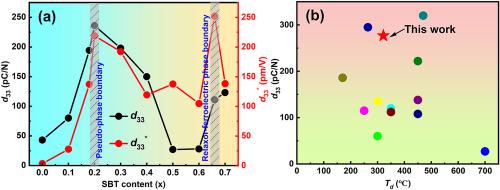Journal of Materiomics ( IF 9.4 ) Pub Date : 2022-05-07 , DOI: 10.1016/j.jmat.2022.04.010 Hongwei Shi 1 , Feng Li 1 , Xinliang Yang 2 , Mingsheng Long 1 , Lei Shan 1 , Chunchang Wang 2 , Jiwei Zhai 3

|
Bismuth ferrite–based ferroelectric ceramics are considered strong competitors in high–temperature piezoelectric applications that benefits from their high depolarization temperature (Td), but problems of large conductivity and low piezoelectric coefficient (d33) should be tackled. BiFeO3 PbTiO3–x(Sr0.7Bi0.2□0.1)TiO3 (BF–PT–xSBT) ternary system are designed in this work that successfully resolves this tough paradox. Rietveld refinements show that this system exhibits multiphase coexistence with complex structural transition among rhombohedral, tetragonal and pseudocubic phase. Interestingly, a high Td ∼320 °C and d33 ∼ 236 pC/N are synergistically optimized in x=0.20 composition near pseudo–phase boundary, which are indicated by multi–scale techniques (phase structure, dielectric analysis etc.). What's more, dual electrostrain peaks appear at separate phase boundaries for x=0.20 and 0.66 compositions with distinct piezo/ferroelectric properties. Rayleigh law and piezoelectric force microscopy analysis clarify that the optimal electrostrain performance for both critical compositions are dominated by intrinsic (x=0.20) and extrinsic (x=0.66) contributions, respectively. This work not only provides a new BF–PT–xSBT system with a high Td and superior d33 that are promising candidates in high–temperature actuator and sensor applications, but also presents a possibility of multiphase–coexistence established exotic macroscopic performances.
PbTiO3–x(Sr0.7Bi0.2□0.1)TiO3 (BF–PT–xSBT) ternary system are designed in this work that successfully resolves this tough paradox. Rietveld refinements show that this system exhibits multiphase coexistence with complex structural transition among rhombohedral, tetragonal and pseudocubic phase. Interestingly, a high Td ∼320 °C and d33 ∼ 236 pC/N are synergistically optimized in x=0.20 composition near pseudo–phase boundary, which are indicated by multi–scale techniques (phase structure, dielectric analysis etc.). What's more, dual electrostrain peaks appear at separate phase boundaries for x=0.20 and 0.66 compositions with distinct piezo/ferroelectric properties. Rayleigh law and piezoelectric force microscopy analysis clarify that the optimal electrostrain performance for both critical compositions are dominated by intrinsic (x=0.20) and extrinsic (x=0.66) contributions, respectively. This work not only provides a new BF–PT–xSBT system with a high Td and superior d33 that are promising candidates in high–temperature actuator and sensor applications, but also presents a possibility of multiphase–coexistence established exotic macroscopic performances.
中文翻译:

BiFeO3PbTiO3-(Sr0.7Bi0.2□0.1)TiO3体系中的高去极化温度和优异的压电性能以及复杂的结构演化
铋铁氧体基铁电陶瓷被认为是高温压电应用中的有力竞争者,这得益于其高去极化温度 ( T d ),但应解决大电导率和低压电系数 ( d 33 ) 的问题。BiFeO 3 PbTiO 3 - x (Sr 0.7 Bi 0.2 □ 0.1 )TiO 3 (BF-PT- xSBT)三元系统在这项工作中设计成功地解决了这个棘手的悖论。Rietveld 改进表明,该系统表现出多相共存,在菱面体、四方体和伪立方相之间具有复杂的结构转变。有趣的是,高T d ∼320 °C 和d 33 ∼ 236 pC/N在伪相界附近的x =0.20 成分中被协同优化,这由多尺度技术(相结构、介电分析等)表明。更重要的是,双电应变峰出现在x的不同相界= 0.20 和 0.66 成分,具有不同的压电/铁电特性。瑞利定律和压电显微镜分析表明,两种关键成分的最佳电应变性能分别由内在 ( x =0.20) 和外在 ( x =0.66) 贡献支配。这项工作不仅提供了一种新的 BF-PT- x SBT 系统,它具有高T d和优异的d 33,是高温执行器和传感器应用的有希望的候选者,而且还提出了多相共存建立的奇异宏观性能的可能性。
PbTiO 3 - x (Sr 0.7 Bi 0.2 □ 0.1 )TiO 3 (BF-PT- xSBT)三元系统在这项工作中设计成功地解决了这个棘手的悖论。Rietveld 改进表明,该系统表现出多相共存,在菱面体、四方体和伪立方相之间具有复杂的结构转变。有趣的是,高T d ∼320 °C 和d 33 ∼ 236 pC/N在伪相界附近的x =0.20 成分中被协同优化,这由多尺度技术(相结构、介电分析等)表明。更重要的是,双电应变峰出现在x的不同相界= 0.20 和 0.66 成分,具有不同的压电/铁电特性。瑞利定律和压电显微镜分析表明,两种关键成分的最佳电应变性能分别由内在 ( x =0.20) 和外在 ( x =0.66) 贡献支配。这项工作不仅提供了一种新的 BF-PT- x SBT 系统,它具有高T d和优异的d 33,是高温执行器和传感器应用的有希望的候选者,而且还提出了多相共存建立的奇异宏观性能的可能性。



























 京公网安备 11010802027423号
京公网安备 11010802027423号